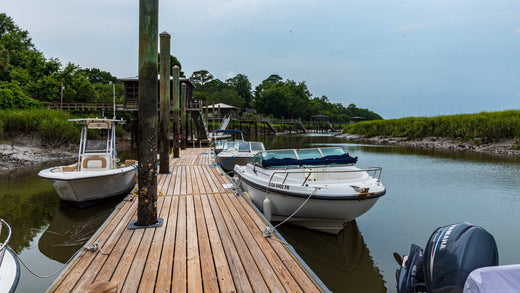
How to Tie Dock Lines: A Guide for Boat Owners and Renters
Nicholas HeislerShare
Docking your boat securely is one of the most crucial skills for any boat owner or renter. Knowing how to tie dock lines properly can prevent damage to your boat and ensure safety at the dock. This guide will walk you through the essential knots and techniques needed for secure docking.
Table of Contents:
- Why Proper Dock Line Tying Matters
- The Basics: Understanding Dock Lines
- Essential Knots for Tying Dock Lines
- Dock Line Setup Techniques
- Final Tips for Docking Your Boat Safely
Why Proper Dock Line Tying Matters
Improperly tied dock lines can lead to your boat drifting, causing potential collisions, damage, or even complete detachment from the dock. By mastering a few essential knots and techniques, you'll be able to secure your boat confidently, whether you're docking in calm or rough waters.
The Basics: Understanding Dock Lines
Before diving into the knots, let's cover the basics of dock lines. Dock lines typically come in three types:
- Bow Line: Runs from the bow (front) of the boat to the dock.
- Stern Line: Runs from the stern (rear) of the boat to the dock.
- Spring Lines: These prevent the boat from moving forward or backward along the dock.
When tying dock lines, it's important to use the correct length and diameter for your boat size. A general rule of thumb is to use dock lines that are 1/8" in diameter for every 9 feet of boat length.
Essential Knots for Tying Dock Lines
To properly secure your boat, you'll need to master a few key knots. Let's explore the most essential ones:
1. The Cleat Hitch
The cleat hitch is the most common and reliable knot for securing dock lines to a cleat on the dock. Here's how to tie it:
- Wrap the line around the base of the cleat.
- Cross the line over the top of the cleat.
- Loop the line under the opposite horn of the cleat.
- Create a figure-eight pattern by crossing the line back over the cleat.
- Finish by making a half-hitch under the final loop to secure it.

The cleat hitch is easy to untie, making it perfect for situations where you need to release the boat quickly.
2. The Bowline Knot
The bowline knot is essential for creating a secure loop at the end of a dock line, which can then be used to tie the line to a piling or other fixed point on the dock. Here's how to tie a bowline:
- Create a small loop in the line, leaving enough rope on the short end.
- Pass the short end of the line through the loop from underneath.
- Wrap the short end around the long end of the line.
- Bring the short end back through the loop from the same side it exited.
- Pull tight to secure the knot.

The bowline knot is strong and won't slip, yet it's easy to untie even after being under load.
3. The Figure-Eight Knot
The figure-eight knot is often used to prevent the end of a line from slipping through a cleat or other mooring point. Here's how to tie it:
- Make a loop in the line.
- Pass the end of the line around the main line and back through the loop.
- Pull the knot tight to secure it.

This simple knot is crucial for ensuring that your dock line remains securely in place.
Want to learn more about knots? Explore the 6 essential boat knots.
Dock Line Setup Techniques
Once you've mastered the knots, it's important to understand how to properly set up your dock lines. Here are a few key techniques:
1. Proper Line Tension
Ensure that your dock lines are not too tight or too loose. Lines that are too tight can cause strain on the boat and dock, while lines that are too loose can allow the boat to drift. Aim for a balanced tension that allows slight movement while keeping the boat secure.
2. Using Spring Lines
Spring lines prevent your boat from moving forward or backward along the dock. Attach one spring line from the bow of the boat to a point on the dock behind the boat's midsection, and another from the stern to a point in front of the boat's midsection.
3. Adjusting for Tides and Weather
If you're docking in an area with significant tides, you'll need to account for rising and falling water levels. Leave enough slack in your dock lines to allow the boat to move with the tide, but not so much that the boat can drift.
In rough weather, consider using additional lines or doubling up on existing ones for added security.
Final Tips for Docking Your Boat Safely
- Check Your Lines Regularly: Even if you've tied your dock lines perfectly, it's important to check them periodically for wear and tear.
- Use Chafing Gear: Protect your dock lines from abrasion by using chafing gear where the lines rub against the boat or dock.
- Practice Makes Perfect: The more you practice tying these knots and setting up dock lines, the more confident and efficient you'll become.
Feeling Prepared to Dock Your Boat?
Learning how to tie dock lines properly is an essential skill for any boat owner or renter. By mastering the cleat hitch, bowline, and figure-eight knots, and understanding the proper setup techniques, you'll ensure your boat is securely docked every time. Remember, the key to safe and secure docking is a combination of the right knots, proper line tension, and regular maintenance.
For more tips and advice on boat maintenance and safety, explore our other blog posts. Safe boating!
When it comes to keeping your boat clean, look to Captains Preferred Products boat cleaning supplies. Find everything you need to keep your vessel squeaky clean all season - always at the best prices.




